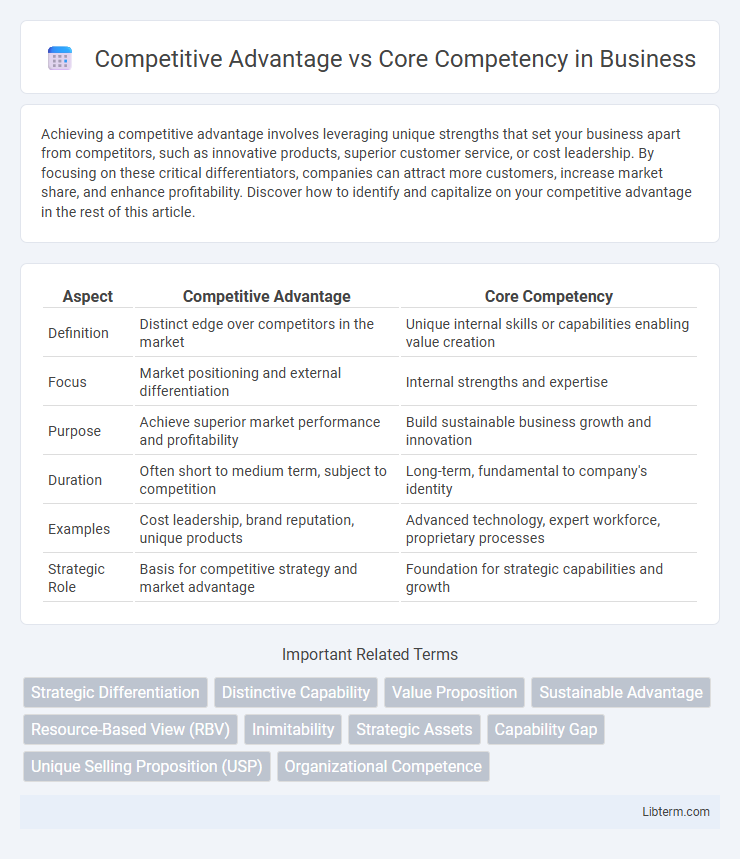Achieving a competitive advantage involves leveraging unique strengths that set your business apart from competitors, such as innovative products, superior customer service, or cost leadership. By focusing on these critical differentiators, companies can attract more customers, increase market share, and enhance profitability. Discover how to identify and capitalize on your competitive advantage in the rest of this article.
Table of Comparison
| Aspect | Competitive Advantage | Core Competency |
|---|---|---|
| Definition | Distinct edge over competitors in the market | Unique internal skills or capabilities enabling value creation |
| Focus | Market positioning and external differentiation | Internal strengths and expertise |
| Purpose | Achieve superior market performance and profitability | Build sustainable business growth and innovation |
| Duration | Often short to medium term, subject to competition | Long-term, fundamental to company's identity |
| Examples | Cost leadership, brand reputation, unique products | Advanced technology, expert workforce, proprietary processes |
| Strategic Role | Basis for competitive strategy and market advantage | Foundation for strategic capabilities and growth |
Introduction to Competitive Advantage and Core Competency
Competitive advantage refers to the unique attributes or capabilities that allow a company to outperform its competitors in the marketplace. Core competency represents the essential skills, technologies, or resources that provide a foundation for a firm's long-term growth and innovation. Understanding the distinction between competitive advantage and core competency helps businesses develop strategies that leverage internal strengths to achieve sustainable market success.
Defining Competitive Advantage
Competitive advantage refers to the attributes or conditions that allow a company to outperform its competitors, providing superior value to customers through cost leadership, differentiation, or niche focus. It is the unique position a business holds in the marketplace, enabling sustained profitability and market share growth. Defining competitive advantage involves analyzing factors such as operational efficiency, brand reputation, product innovation, and customer loyalty that collectively contribute to a firm's distinctive edge.
Understanding Core Competency
Core competency refers to a company's unique strengths and capabilities that provide a strategic advantage and are difficult for competitors to imitate. It encompasses specialized knowledge, skills, technologies, and processes that enable the firm to deliver distinctive value to customers and enter new markets effectively. Understanding and leveraging core competencies allow businesses to build sustainable competitive advantage by focusing on areas with the greatest impact on long-term success.
Key Differences Between Competitive Advantage and Core Competency
Competitive advantage refers to the unique edge a company holds that allows it to outperform competitors in the market, often derived from factors like cost leadership, product differentiation, or branding. Core competency, on the other hand, is the collective knowledge, skills, and abilities that enable a firm to deliver unique value and sustain its competitive advantage. While competitive advantage is outcome-focused and market-driven, core competency is capability-focused and internal to the organization.
The Role of Competitive Advantage in Business Success
Competitive advantage drives business success by enabling companies to outperform rivals through unique value propositions, cost leadership, or superior quality. Core competencies, as internal capabilities like expertise, innovation, and operational efficiency, support the development and sustainment of these advantages. Firms leveraging competitive advantage effectively achieve higher market share, profitability, and long-term growth.
How Core Competencies Drive Organizational Growth
Core competencies are unique strengths and capabilities that provide a foundation for sustainable competitive advantage by enabling innovation, efficiency, and superior customer value. Organizations leverage core competencies to develop new products, enter new markets, and adapt to industry changes more effectively than competitors. By continuously nurturing these distinctive skills, companies drive long-term growth and maintain a strong market position.
Examples of Competitive Advantage in Leading Companies
Amazon's competitive advantage lies in its advanced logistics network and vast product selection, enabling rapid delivery and customer convenience unmatched by competitors. Apple leverages its core competency in innovative product design and ecosystem integration to maintain a loyal customer base and premium pricing. Tesla's competitive advantage stems from its leading battery technology and robust Supercharger network, establishing dominance in the electric vehicle market.
Case Studies on Core Competency Utilization
Case studies on core competency utilization reveal how companies like Apple leverage their design and innovation skills to maintain a competitive advantage in technology markets. Toyota's emphasis on lean manufacturing exemplifies core competency driving operational excellence, creating sustained competitive differentiation. These examples demonstrate that effectively harnessing core competencies solidifies market position beyond temporary competitive advantages.
Aligning Core Competency with Competitive Advantage Strategies
Aligning core competencies with competitive advantage strategies involves leveraging unique organizational strengths to create sustainable market value and outperform competitors. Core competencies such as specialized knowledge, efficient processes, or innovative capabilities should directly support strategic goals like cost leadership or differentiation to enhance overall business performance. This alignment ensures that resources are optimally utilized, enabling firms to maintain a competitive edge and adapt to changing market dynamics.
Conclusion: Integrating Competitive Advantage and Core Competency for Sustained Success
Integrating competitive advantage and core competency enables businesses to sustain long-term success by leveraging unique strengths and market positioning simultaneously. Focusing on core competencies enhances innovation and operational efficiency, while competitive advantages capitalize on differentiated value propositions that outpace rivals. A strategic blend of both fosters resilience, adaptability, and sustained superior performance in dynamic markets.
Competitive Advantage Infographic

 libterm.com
libterm.com